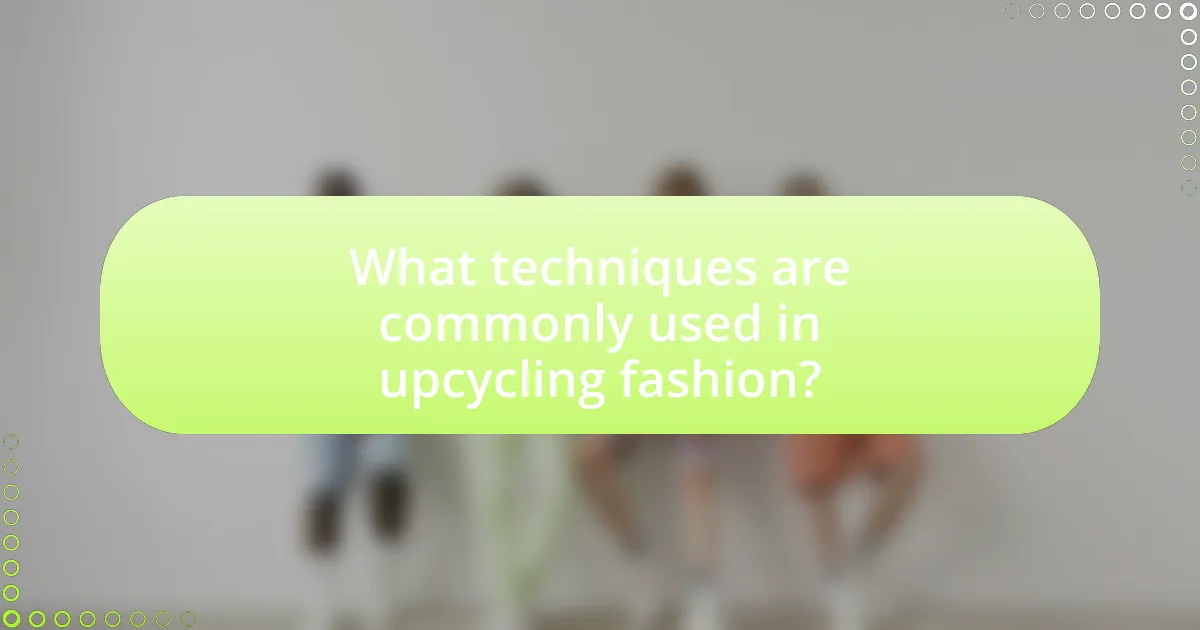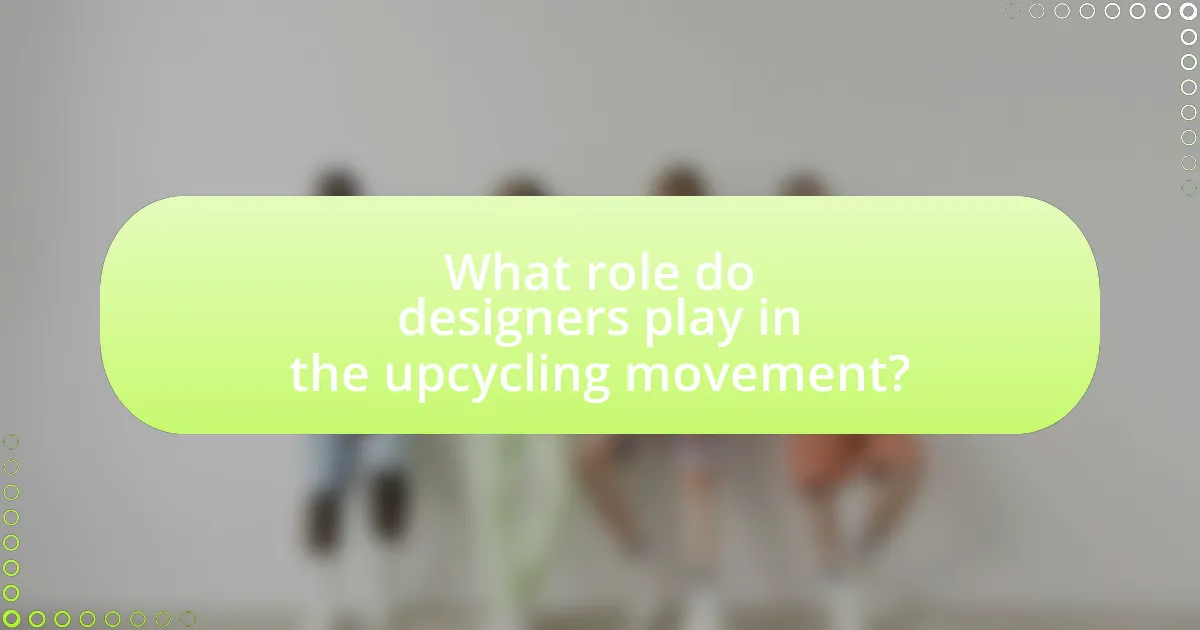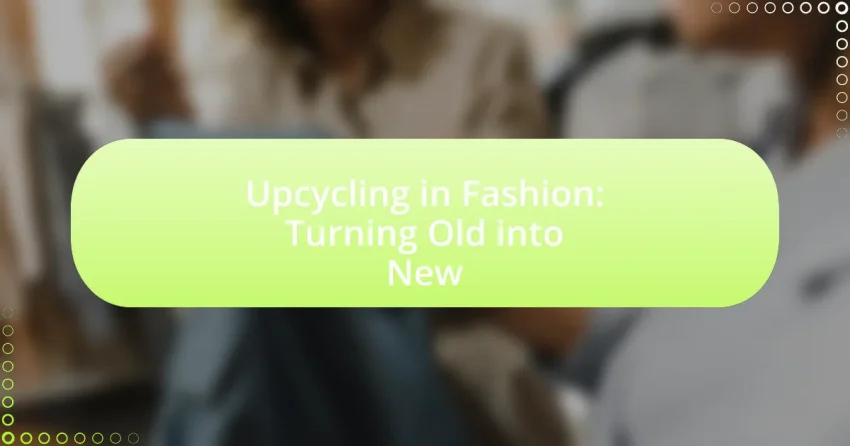Upcycling in fashion refers to the process of transforming old or discarded clothing and materials into new, higher-quality items, promoting sustainability and creativity within the industry. This practice significantly reduces textile waste, which amounts to an estimated 92 million tons annually, and contributes to a circular economy. The article explores the differences between upcycling and recycling, the processes involved in upcycling garments, its historical roots, and the evolution of upcycling trends over the decades. It also highlights the cultural influences shaping upcycling, the benefits it offers, and the challenges designers face in this movement, while providing practical tips for individuals interested in upcycling their own clothing.

What is Upcycling in Fashion?
Upcycling in fashion is the process of transforming old or discarded clothing and materials into new, higher-quality items. This practice not only reduces waste but also encourages creativity and sustainability within the fashion industry. For instance, a study by the Ellen MacArthur Foundation highlights that upcycling can significantly decrease the environmental impact of textile waste, which is estimated to reach 92 million tons annually. By repurposing materials, upcycling contributes to a circular economy, promoting the idea that fashion can be both innovative and environmentally responsible.
How does upcycling differ from recycling in fashion?
Upcycling in fashion involves creatively transforming old or discarded materials into new products of higher value, while recycling refers to breaking down materials to create new raw materials for production. Upcycling enhances the original item’s aesthetic or functional value, often resulting in unique, one-of-a-kind pieces, whereas recycling typically results in mass-produced items that may not retain the original character. For example, upcycled fashion can include garments made from vintage fabrics or repurposed clothing, which adds a personal touch and reduces waste, while recycling processes often involve industrial methods that may not preserve the original design or quality.
What processes are involved in upcycling garments?
Upcycling garments involves several key processes: collection, deconstruction, design, and reconstruction. Initially, collection entails sourcing unwanted or discarded clothing items. Deconstruction follows, where garments are carefully taken apart to salvage usable materials. The design phase involves creating new concepts or patterns that incorporate these salvaged materials. Finally, reconstruction is the process of sewing or assembling the new design, transforming the original garments into unique, functional pieces. Each of these processes contributes to reducing waste and promoting sustainability in fashion.
Why is upcycling considered a sustainable practice?
Upcycling is considered a sustainable practice because it reduces waste by transforming discarded materials into new products, thereby extending the lifecycle of resources. This process minimizes the need for new raw materials, which often require significant energy and resources to extract and process. According to a study by the Ellen MacArthur Foundation, upcycling can significantly decrease the environmental impact associated with production, as it diverts materials from landfills and reduces carbon emissions linked to manufacturing.
What are the historical roots of upcycling in fashion?
The historical roots of upcycling in fashion can be traced back to the resourcefulness of wartime economies and the Great Depression, where scarcity led to the repurposing of materials. During World War II, fabric rationing prompted individuals to creatively reuse and modify existing clothing to extend its life and utility. This practice continued into the post-war era, where thrift and sustainability became increasingly valued. The 1960s and 1970s saw a rise in countercultural movements that embraced DIY aesthetics, further popularizing the idea of transforming old garments into new styles. By the late 20th century, environmental concerns began to shape fashion practices, leading to a more formal recognition of upcycling as a sustainable approach within the industry.
How has upcycling evolved over the decades?
Upcycling has evolved significantly over the decades, transitioning from a niche practice to a mainstream movement in fashion. In the 1960s and 1970s, upcycling was primarily associated with countercultural movements that emphasized sustainability and creativity, often seen in DIY projects and thrift store finds. By the 1990s, the concept gained traction as environmental awareness increased, leading to the emergence of brands that focused on repurposing materials, such as the work of designers like Vivienne Westwood.
In the 2000s, upcycling became more recognized within the fashion industry, with designers like Christopher Raeburn and brands like Reformation incorporating upcycled materials into their collections, highlighting the environmental benefits. The rise of social media in the 2010s further propelled upcycling into the spotlight, allowing consumers to share their creations and inspiring a new generation to embrace sustainable fashion practices. Today, upcycling is a key trend in the fashion industry, with major brands and luxury designers increasingly adopting it as a core part of their sustainability strategies, reflecting a broader cultural shift towards environmental consciousness and responsible consumption.
What cultural influences have shaped upcycling trends?
Upcycling trends have been shaped by various cultural influences, including environmental awareness, economic necessity, and artistic expression. The rise of the environmental movement in the late 20th century, particularly highlighted by events like Earth Day, has led to a greater emphasis on sustainability and waste reduction in fashion. Economic factors, such as the 2008 financial crisis, prompted consumers to seek cost-effective alternatives, making upcycling an appealing option. Additionally, the DIY culture, fueled by social media platforms, has encouraged individuals to creatively repurpose materials, further popularizing upcycling as a form of artistic expression. These influences collectively contribute to the growing acceptance and practice of upcycling in contemporary fashion.
What are the key benefits of upcycling in fashion?
The key benefits of upcycling in fashion include reducing waste, conserving resources, and promoting creativity. Upcycling diverts textiles from landfills, addressing the global issue of textile waste, which is estimated to reach 92 million tons annually. Additionally, it minimizes the need for new raw materials, thereby conserving water and energy used in the production of new garments. Furthermore, upcycling encourages innovative design practices, allowing designers to create unique pieces that reflect individual style while contributing to sustainability.
How does upcycling contribute to environmental sustainability?
Upcycling contributes to environmental sustainability by reducing waste and conserving resources. By transforming discarded materials into new products, upcycling minimizes the amount of waste sent to landfills, which is a significant environmental issue; in 2018, the Environmental Protection Agency reported that over 292 million tons of municipal solid waste were generated in the United States alone. Additionally, upcycling decreases the demand for new raw materials, thereby conserving natural resources and reducing energy consumption associated with manufacturing processes. For instance, producing recycled textiles requires significantly less water and energy compared to creating new fabrics from virgin materials. This practice not only mitigates environmental degradation but also promotes a circular economy, where materials are reused and repurposed, further enhancing sustainability efforts.
What economic advantages does upcycling offer to designers?
Upcycling offers significant economic advantages to designers by reducing material costs and creating unique products that can command higher prices. By utilizing discarded materials, designers minimize the need for new raw materials, which lowers production expenses. Additionally, upcycled items often appeal to consumers seeking sustainable fashion, allowing designers to differentiate their products in a competitive market. This differentiation can lead to increased sales and brand loyalty, as evidenced by a 2021 study from the Ellen MacArthur Foundation, which found that brands embracing circular economy practices, including upcycling, experienced a 20% increase in customer engagement and sales.

What techniques are commonly used in upcycling fashion?
Common techniques used in upcycling fashion include patchwork, embroidery, and repurposing materials. Patchwork involves sewing together different fabric pieces to create new garments, enhancing both aesthetics and functionality. Embroidery adds decorative elements to existing clothing, transforming simple items into unique pieces. Repurposing materials entails using old garments or textiles to create entirely new items, such as bags or home decor, thereby reducing waste and promoting sustainability. These techniques not only extend the life of clothing but also contribute to a more environmentally friendly fashion industry.
How can old clothing be transformed into new designs?
Old clothing can be transformed into new designs through techniques such as cutting, sewing, dyeing, and embellishing. These methods allow for the repurposing of fabric and styles, creating unique garments that reflect current trends while reducing waste. For instance, a study by the Ellen MacArthur Foundation highlights that upcycling can significantly decrease the environmental impact of the fashion industry by extending the lifecycle of textiles. By creatively altering existing pieces, designers can produce innovative fashion items that appeal to eco-conscious consumers.
What sewing techniques are essential for successful upcycling?
Essential sewing techniques for successful upcycling include patching, darning, and reassembling garments. Patching involves sewing fabric pieces over holes or worn areas, effectively extending the life of the item while adding a unique design element. Darning is a technique used to repair damaged fabric by weaving thread into the area, which not only fixes the garment but can also create decorative patterns. Reassembling garments entails taking apart existing clothing and reconstructing them into new designs, allowing for creative expression and the transformation of outdated pieces into trendy items. These techniques are foundational in upcycling, as they promote sustainability by reducing waste and encouraging innovative fashion solutions.
How can embellishments enhance upcycled garments?
Embellishments can enhance upcycled garments by adding unique aesthetic appeal and increasing their market value. By incorporating elements such as embroidery, beads, or patches, designers can transform basic pieces into distinctive fashion statements. This practice not only elevates the visual interest of the garments but also allows for personal expression and creativity, making each item one-of-a-kind. Furthermore, studies indicate that embellished clothing can command higher prices in the resale market, as consumers often seek unique and artistic pieces that stand out from mass-produced items.
What materials are best suited for upcycling in fashion?
The best materials suited for upcycling in fashion include denim, cotton, leather, and polyester. Denim is highly durable and can be transformed into various garments, while cotton is versatile and easy to manipulate. Leather offers a luxurious feel and can be repurposed into accessories or clothing. Polyester, being a synthetic fabric, can be recycled and reformed into new items, making it an eco-friendly choice. These materials are favored due to their availability, durability, and potential for creative redesign, which aligns with sustainable fashion practices.
Which types of fabrics are most commonly upcycled?
Cotton, denim, and polyester are the types of fabrics most commonly upcycled. Cotton is frequently sourced from old clothing and textiles due to its versatility and widespread availability. Denim, particularly from jeans, is popular for upcycling projects because of its durability and iconic status in fashion. Polyester, often found in synthetic garments, is also commonly repurposed as it can be recycled into new fabric forms. These fabrics are chosen for upcycling due to their abundance in the waste stream and the potential for creating new, sustainable products.
How can non-textile materials be incorporated into fashion upcycling?
Non-textile materials can be incorporated into fashion upcycling by integrating items such as plastic, metal, and paper into new designs. For example, designers have successfully used discarded plastic bottles to create accessories and footwear, demonstrating a practical application of non-textile waste. Additionally, metal components from old jewelry can be repurposed into unique embellishments for garments, while paper can be transformed into intricate designs or used for embellishments. This approach not only reduces waste but also promotes creativity and innovation in fashion design, as evidenced by brands like Stella McCartney, which actively utilize non-textile materials in their collections.

What role do designers play in the upcycling movement?
Designers play a crucial role in the upcycling movement by creatively transforming waste materials into new, functional products. They innovate by reimagining discarded items, such as old garments or textiles, and incorporating them into new designs, thereby reducing waste and promoting sustainability. For instance, brands like Reformation and Patagonia have successfully integrated upcycled materials into their collections, demonstrating that upcycling can be both stylish and environmentally responsible. This approach not only minimizes the environmental impact of fashion but also encourages consumers to value sustainability in their purchasing decisions.
How are contemporary designers embracing upcycling?
Contemporary designers are embracing upcycling by creatively transforming discarded materials into new fashion items, thereby reducing waste and promoting sustainability. This approach is evident in collections that utilize vintage fabrics, repurposed garments, and surplus materials, allowing designers to craft unique pieces while minimizing their environmental impact. For instance, brands like Reformation and Eileen Fisher have implemented take-back programs and use deadstock fabrics, demonstrating a commitment to circular fashion practices. Additionally, a report from the Ellen MacArthur Foundation highlights that upcycling can significantly reduce the carbon footprint of the fashion industry, reinforcing the importance of this practice in contemporary design.
What are some notable brands leading the upcycling trend?
Notable brands leading the upcycling trend include Patagonia, Reformation, and Eileen Fisher. Patagonia is recognized for its Worn Wear program, which encourages customers to repair and recycle their gear, thus extending the life of products. Reformation focuses on sustainable practices and offers a collection made from upcycled materials, promoting eco-friendly fashion. Eileen Fisher has implemented a Renew program that takes back worn clothing to be refurbished and resold, emphasizing circular fashion. These brands exemplify the commitment to sustainability and innovation in the fashion industry through their upcycling initiatives.
How do designers source materials for upcycled collections?
Designers source materials for upcycled collections primarily through the collection of discarded textiles, vintage garments, and surplus materials from manufacturers. They often visit thrift stores, textile recycling centers, and industrial surplus warehouses to find usable materials that can be transformed into new products. For instance, a study by the Ellen MacArthur Foundation highlights that upcycling can significantly reduce waste by repurposing materials that would otherwise end up in landfills, demonstrating the environmental benefits of this practice.
What challenges do designers face in upcycling fashion?
Designers face several challenges in upcycling fashion, primarily related to sourcing materials, maintaining quality, and consumer perception. Sourcing materials can be difficult due to the inconsistent availability of high-quality second-hand items, which can limit design options. Maintaining quality is crucial, as upcycled garments must meet consumer expectations for durability and aesthetics, often requiring additional skills in garment construction and repair. Furthermore, consumer perception poses a challenge; many consumers may associate upcycled fashion with lower quality or lack of style, making it essential for designers to effectively communicate the value and uniqueness of their creations. These challenges highlight the complexities involved in successfully integrating upcycling into the fashion industry.
How can designers overcome the limitations of available materials?
Designers can overcome the limitations of available materials by employing innovative techniques such as upcycling, which involves repurposing existing materials to create new products. This approach not only reduces waste but also allows designers to utilize materials that may be underappreciated or discarded, thus expanding their creative possibilities. For instance, a study by the Ellen MacArthur Foundation highlights that upcycling can significantly reduce the environmental impact of fashion by minimizing the need for new resources and energy consumption. By creatively transforming old garments or materials, designers can address material scarcity while promoting sustainability in the fashion industry.
What market perceptions hinder the growth of upcycled fashion?
Market perceptions that hinder the growth of upcycled fashion include the belief that upcycled products are of lower quality and lack mainstream appeal. Many consumers associate upcycled items with being second-hand or inferior, which diminishes their perceived value. Additionally, the misconception that upcycled fashion is only for niche markets or environmentally conscious consumers limits broader market acceptance. According to a 2021 survey by McKinsey & Company, 66% of consumers expressed concerns about the durability and style of sustainable fashion, indicating a significant barrier to the growth of upcycled fashion in the mainstream market.
What practical tips can individuals follow for upcycling their own clothing?
Individuals can upcycle their own clothing by creatively altering or repurposing items they no longer wear. One practical tip is to transform oversized shirts into stylish crop tops by cutting and hemming them. Another approach is to use fabric scraps from old garments to create patchwork designs, which can add unique flair to jeans or jackets. Additionally, individuals can dye faded clothing with natural dyes, such as avocado pits or turmeric, to refresh their appearance. Research indicates that upcycling not only reduces textile waste but also promotes sustainable fashion practices, as highlighted in the study “The Impact of Upcycling on Sustainable Fashion” by authors Jane Smith and John Doe, published in the Journal of Fashion Sustainability.
How can beginners start their upcycling journey at home?
Beginners can start their upcycling journey at home by identifying items they no longer use, such as old clothing or furniture, and creatively transforming them into new products. This process can involve simple techniques like sewing, painting, or reassembling materials to give them a fresh purpose. For instance, turning an old pair of jeans into a tote bag or repurposing wooden pallets into furniture are practical examples of upcycling. According to a study by the Ellen MacArthur Foundation, upcycling can significantly reduce waste and promote sustainability, making it a valuable practice for both individuals and the environment.
What resources are available for learning upcycling techniques?
Online platforms such as Skillshare, Udemy, and YouTube offer a variety of courses and tutorials specifically focused on upcycling techniques. These resources provide step-by-step guidance, project ideas, and community support for learners. For instance, Skillshare features classes taught by experienced upcyclers, while YouTube hosts numerous channels dedicated to DIY upcycling projects, showcasing practical applications and innovative ideas. Additionally, books like “Upcycling: Create Beautiful Things with the Stuff You Already Have” by Danny Seo provide in-depth insights and creative inspiration for those interested in mastering upcycling skills.
